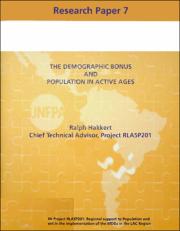Please use this identifier to cite or link to this item:
https://repositorio.ipea.gov.br/handle/11058/14004Full metadata record
| DC Field | Value | Language |
|---|---|---|
| dc.contributor.author | Hakkert, Ralph | - |
| dc.date.accessioned | 2024-06-11T19:52:49Z | - |
| dc.date.available | 2024-06-11T19:52:49Z | - |
| dc.date.issued | 2007-10 | - |
| dc.identifier.citation | HAKKERT, Ralph. The Demographic bonus and population in active ages. Brasília: Ipea: UNFPA, 2007. (Research Paper; 7). Disponível em: https://repositorio.ipea.gov.br/handle/11058/14004 | pt_BR |
| dc.identifier.uri | https://repositorio.ipea.gov.br/handle/11058/14004 | - |
| dc.description.abstract | O conceito de "bônus demográfico" ou "dividendo demográfico" refere-se às oportunidades econômicas e sociais resultantes da transição demográfica, onde há uma maior proporção de população em idade ativa em comparação aos dependentes. Este fenômeno pode impactar positivamente diversos Objetivos de Desenvolvimento do Milênio (ODM), como a redução da pobreza, melhoria na educação, igualdade de gênero, saúde materna e infantil, e sustentabilidade ambiental. No entanto, a realização desses benefícios depende de fatores econômicos, políticos e sociais favoráveis, bem como de políticas adequadas. Além disso, há a possibilidade de um "segundo bônus demográfico", decorrente do aumento da poupança e investimento impulsionado pelo envelhecimento populacional. A experiência da Ásia Oriental serve como exemplo do impacto positivo desse fenômeno no crescimento econômico, enquanto em regiões como a América Latina, os benefícios observados ainda estão abaixo do potencial. | pt_BR |
| dc.language.iso | en-US | pt_BR |
| dc.publisher | Instituto de Pesquisa Econômica Aplicada (Ipea) | pt_BR |
| dc.publisher | United Nations Population Fund (UNFPA) | pt_BR |
| dc.title | The Demographic bonus and population in active ages | pt_BR |
| dc.type | Livros | pt_BR |
| dc.rights.holder | Instituto de Pesquisa Econômica Aplicada (Ipea) | pt_BR |
| dc.rights.holder | United Nations Population Fund (UNFPA) | pt_BR |
| dc.source.urlsource | https://www.ipea.gov.br | pt_BR |
| dc.location.country | BR | pt_BR |
| dc.description.physical | 44 p. : il. | pt_BR |
| dc.subject.vcipea | IPEA::Demografia. População::Dinâmica Populacional::População::Mudança Demográfica | pt_BR |
| dc.rights.license | Reproduction of this text and the data it contains is allowed as long as the source is cited. Reproductions for commercial purposes are prohibited. É permitida a reprodução deste texto e dos dados nele contidos, desde que citada a fonte. Reproduções para fins comerciais são proibidas | pt_BR |
| dc.subject.keyword | Mudança demográfica | pt_BR |
| dc.subject.keyword | Mercado de trabalho | pt_BR |
| dc.subject.keyword | Mão de obra | pt_BR |
| ipea.description.additionalinformation | Série: (Research Paper; 7) | pt_BR |
| ipea.description.additionalinformation | Financiamento: IPEA/UNFPA Project RLA5P20: Regional support to population and development in the implementation of the MDGs in the LAC Region | pt_BR |
| ipea.access.type | Acesso Aberto | pt_BR |
| ipea.rights.type | Licença Padrão Ipea | pt_BR |
| ipea.englishdescription.abstract | The concept of the "demographic bonus" or "demographic dividend" refers to the economic and social opportunities arising from the demographic transition, where there is a higher proportion of the working-age population compared to dependents. This phenomenon can positively impact various Millennium Development Goals (MDGs), such as poverty reduction, education improvement, gender equality, maternal and child health, and environmental sustainability. However, realizing these benefits depends on favorable economic, political, and social conditions, as well as appropriate policies. Additionally, there is the potential for a "second demographic bonus" resulting from increased savings and investment driven by population aging. The experience of East Asia exemplifies the positive impact of this phenomenon on economic growth, while regions like Latin America have yet to fully realize its potential benefits. | pt_BR |
| ipea.researchfields | N/A | pt_BR |
| ipea.classification | Demografia. População | pt_BR |
| Appears in Collections: | Demografia. População: Livros | |
Files in This Item:
| File | Description | Size | Format | |
|---|---|---|---|---|
| the_demographic_bonus.pdf | 4.81 MB | Adobe PDF |  View/Open |
Items in DSpace are protected by copyright, with all rights reserved, unless otherwise indicated.

